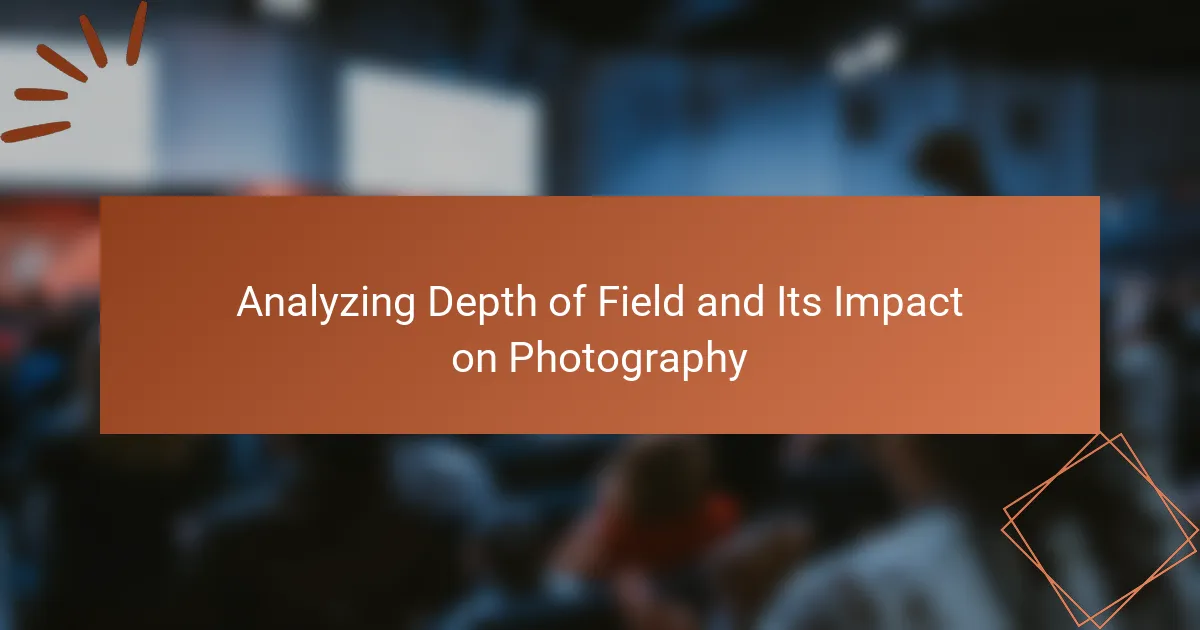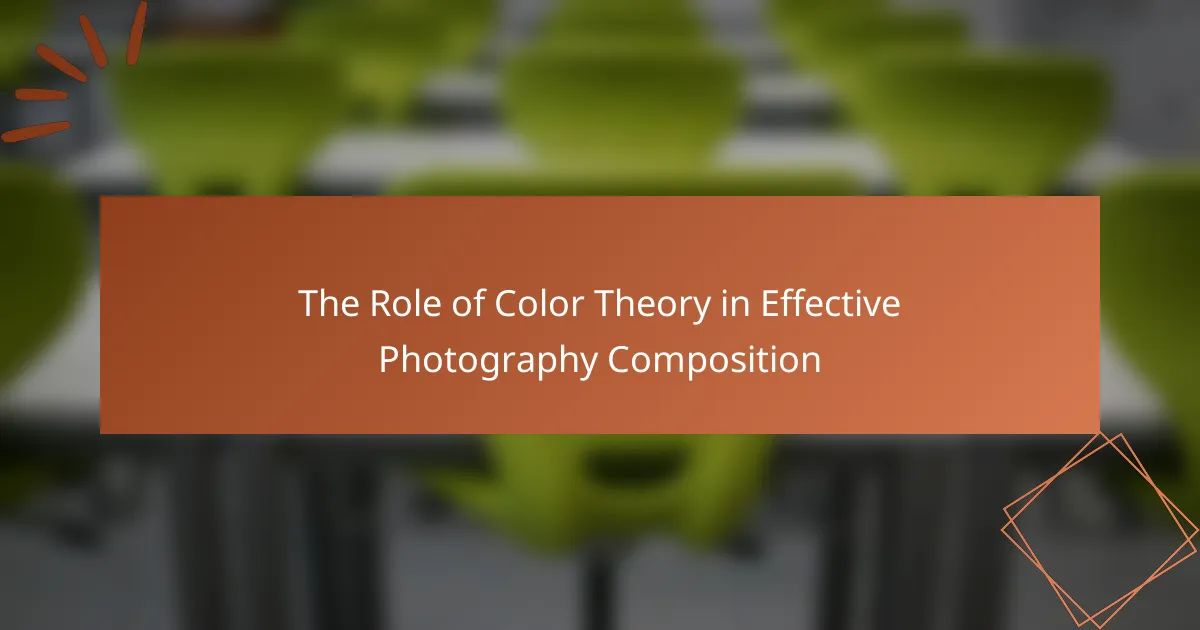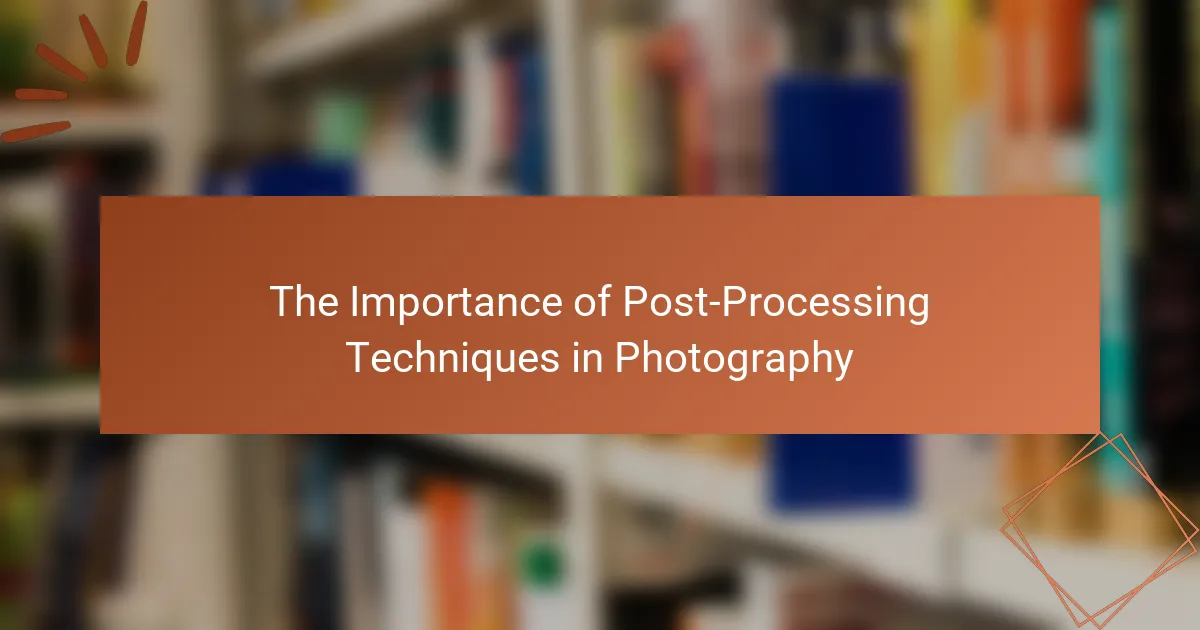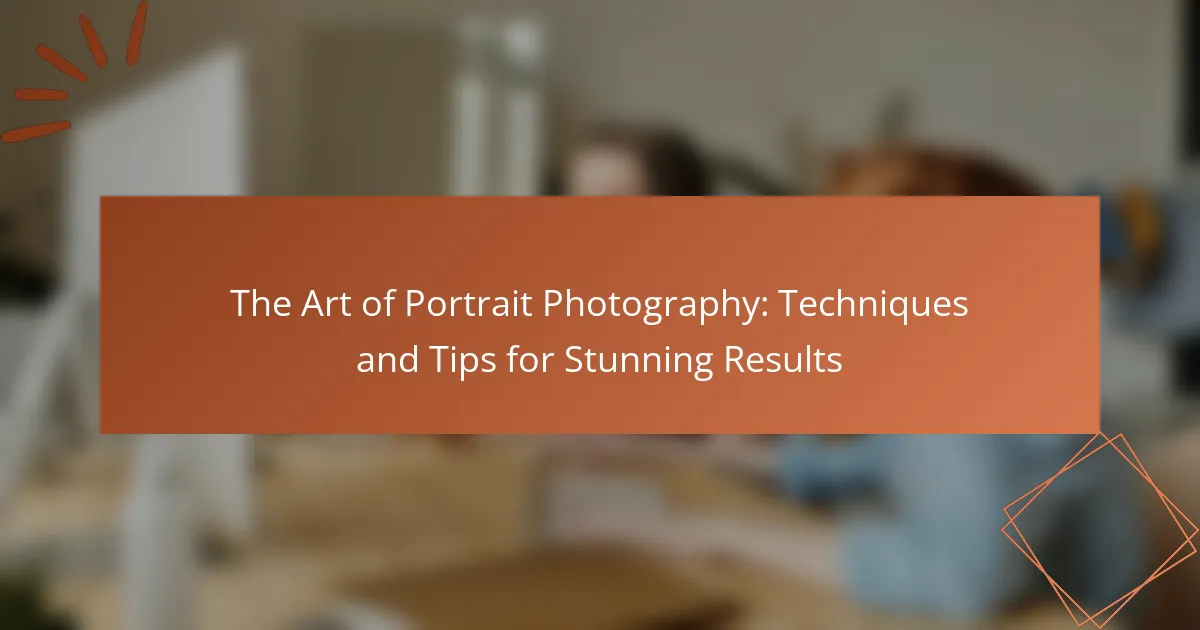Exposure techniques in photography are methods used to control the amount of light that reaches the camera sensor, primarily through adjustments in aperture, shutter speed, and ISO settings. Each of these elements plays a crucial role in determining the overall exposure and quality of an image. The article explores various exposure techniques, including aperture priority, shutter priority, manual mode, and program mode, detailing their specific applications and benefits. Additionally, it emphasizes the importance of practice and experimentation in mastering these techniques, as well as the value of tools and resources for photographers seeking to improve their skills in different lighting conditions. Understanding these concepts is essential for achieving well-balanced and visually appealing photographs.
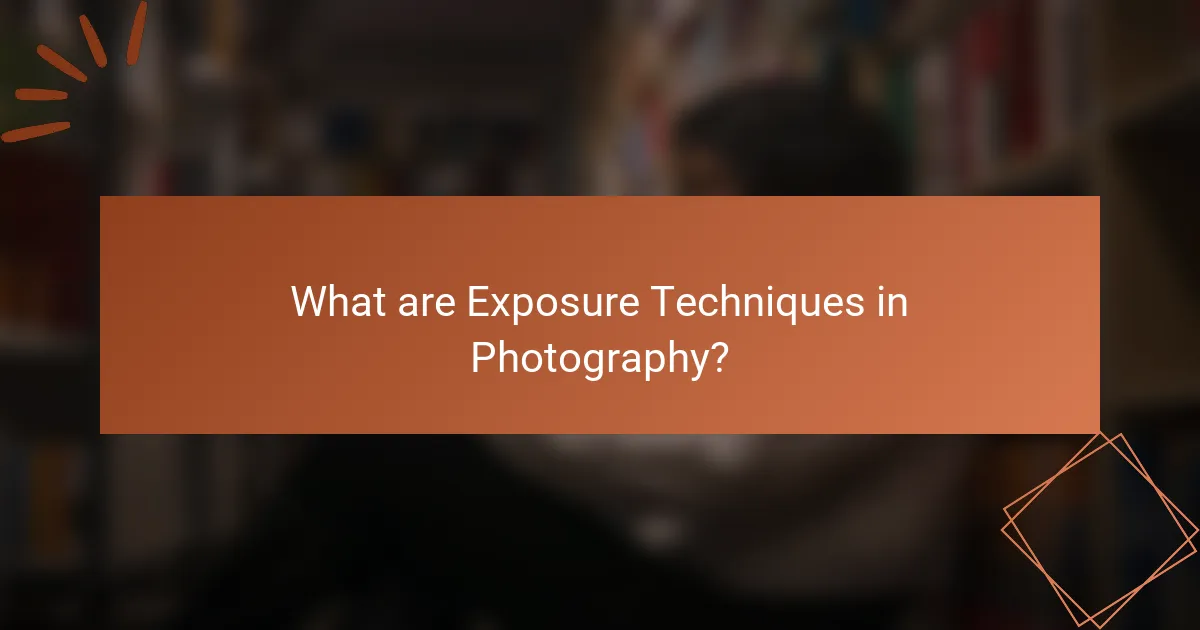
What are Exposure Techniques in Photography?
Exposure techniques in photography refer to methods used to control the amount of light that reaches the camera sensor. These techniques include adjusting the aperture, shutter speed, and ISO settings. The aperture controls the size of the lens opening, affecting depth of field and brightness. Shutter speed determines how long the sensor is exposed to light, impacting motion blur. ISO measures the sensor’s sensitivity to light, influencing image noise. Mastering these techniques allows photographers to achieve desired effects and proper exposure in various lighting conditions. Understanding exposure is essential for creating well-balanced images.
How do Exposure Techniques impact the quality of photographs?
Exposure techniques significantly impact the quality of photographs. Proper exposure controls brightness, contrast, and detail in images. Underexposed photos can appear too dark, losing essential details. Overexposed images may wash out colors and textures. Correct exposure enhances clarity and sharpness. The exposure triangle—aperture, shutter speed, and ISO—works together to achieve optimal results. For instance, a wider aperture allows more light, creating a shallow depth of field. Conversely, a fast shutter speed freezes motion, preventing blur. Understanding these techniques leads to better photographic outcomes.
What are the key components of exposure in photography?
The key components of exposure in photography are aperture, shutter speed, and ISO. Aperture controls the amount of light entering the camera. It is measured in f-stops, with lower numbers allowing more light. Shutter speed determines how long the camera sensor is exposed to light. Faster shutter speeds freeze motion, while slower speeds create blur. ISO measures the sensor’s sensitivity to light. Higher ISO settings allow for shooting in low-light conditions but can introduce noise. Together, these components work to achieve a well-exposed image. Understanding their interplay is essential for effective photography.
How does exposure affect light and shadow in images?
Exposure determines the amount of light that reaches the camera sensor. It directly influences the brightness and darkness in an image. Higher exposure results in brighter images, reducing shadow detail. Conversely, lower exposure creates darker images, enhancing shadow contrast. This relationship is crucial in photography. Proper exposure balances highlights and shadows, achieving a desired mood. Inadequate exposure can lead to loss of detail in both bright and dark areas. Photographers often adjust exposure settings to control light and shadow effectively.
Why is understanding Exposure Techniques essential for photographers?
Understanding exposure techniques is essential for photographers because it directly impacts image quality. Proper exposure allows photographers to capture the desired brightness and detail in their images. Mastering exposure techniques helps prevent overexposed or underexposed photos. It also enables photographers to create specific moods and effects through light manipulation. For instance, adjusting aperture, shutter speed, and ISO can dramatically change the outcome of a photograph. According to a study by the American Society of Media Photographers, well-exposed images are more likely to engage viewers. Therefore, understanding exposure techniques is crucial for achieving professional and aesthetically pleasing results.
How can mastering exposure improve a photographer’s skills?
Mastering exposure enhances a photographer’s skills by allowing precise control over image brightness and detail. Photographers learn to manipulate aperture, shutter speed, and ISO settings. This knowledge leads to better creative choices in various lighting conditions. Accurate exposure helps in capturing the intended mood and atmosphere of a scene. It also reduces the need for extensive post-processing. Mastery of exposure enables photographers to shoot in challenging environments, such as low light or high contrast situations. Ultimately, improved exposure skills contribute to more professional-looking images.
What common mistakes do photographers make regarding exposure?
Photographers commonly make mistakes such as not understanding the exposure triangle. The exposure triangle includes aperture, shutter speed, and ISO. Misjudging these elements leads to overexposed or underexposed images. Many photographers also fail to adjust exposure settings based on lighting conditions. For instance, shooting in bright sunlight without adjusting settings can result in blown highlights. Another mistake is relying too heavily on auto mode. This can prevent photographers from learning manual settings that provide better control. Additionally, not using a histogram to evaluate exposure is a frequent oversight. Histograms help in assessing whether an image is properly exposed. Lastly, ignoring the impact of lens choice on exposure can lead to poor results. Each lens has different characteristics that affect light intake.
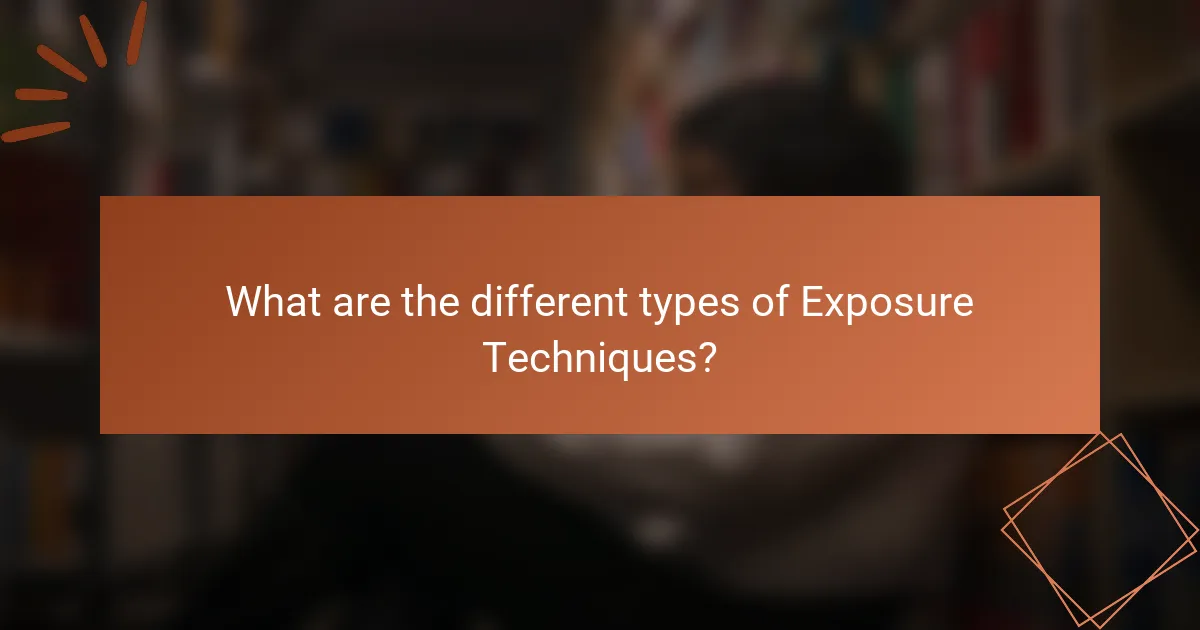
What are the different types of Exposure Techniques?
The different types of exposure techniques in photography include aperture priority, shutter priority, manual mode, and program mode. Aperture priority allows the photographer to set the aperture while the camera adjusts the shutter speed. This technique is useful for controlling depth of field. Shutter priority lets the photographer choose the shutter speed, with the camera adjusting the aperture. This is ideal for capturing motion. Manual mode provides complete control over both aperture and shutter speed, allowing for creative flexibility. Program mode automatically selects both settings, suitable for quick shooting situations. Each technique serves distinct purposes and helps photographers achieve desired effects in their images.
What is the difference between Aperture, Shutter Speed, and ISO?
Aperture, shutter speed, and ISO are the three fundamental components of exposure in photography. Aperture refers to the size of the lens opening, which controls the amount of light entering the camera. A larger aperture (smaller f-number) allows more light, resulting in a brighter image and a shallower depth of field. Shutter speed is the duration the camera’s shutter remains open, affecting how long light hits the sensor. A faster shutter speed freezes motion, while a slower speed can create motion blur. ISO measures the sensitivity of the camera sensor to light. A higher ISO increases sensitivity, allowing for better performance in low light but may introduce noise. Together, these three elements work in harmony to achieve proper exposure and creative effects in photography.
How does aperture affect depth of field in photography?
Aperture directly influences depth of field in photography. A wider aperture (lower f-stop number) results in a shallower depth of field. This means that only a small portion of the image will be in focus, creating a blurred background. Conversely, a narrower aperture (higher f-stop number) increases depth of field. This allows more of the scene to be in focus, from foreground to background.
The relationship between aperture and depth of field is crucial for creative control in photography. Photographers often use this relationship to isolate subjects or create expansive landscapes. For instance, using an aperture of f/2.8 can yield a pronounced background blur, ideal for portrait photography. In contrast, an aperture of f/11 is preferable for landscape shots, ensuring sharpness throughout the image.
What role does shutter speed play in capturing motion?
Shutter speed determines how long a camera’s sensor is exposed to light. It plays a crucial role in capturing motion by controlling the amount of blur in the image. A fast shutter speed freezes motion, making it ideal for action shots. For example, a shutter speed of 1/1000 second can capture a bird in flight without blur. Conversely, a slow shutter speed creates motion blur, which can convey movement. A shutter speed of 1/30 second may show the motion of a flowing waterfall. Therefore, adjusting shutter speed is essential for achieving the desired effect in motion photography.
How does ISO influence the sensitivity of the camera sensor?
ISO directly influences the sensitivity of the camera sensor. Higher ISO settings increase the sensor’s sensitivity to light. This allows for better performance in low-light conditions. For instance, an ISO of 1600 is four times more sensitive than an ISO of 400. This means the camera can capture images with less light. However, higher ISO settings can introduce noise, reducing image quality. The trade-off between sensitivity and noise is crucial for photographers. Balancing ISO with aperture and shutter speed is essential for optimal exposure.
How can these Exposure Techniques be combined effectively?
Exposure techniques can be combined effectively by understanding their interdependence. Photographers can adjust aperture, shutter speed, and ISO to achieve desired exposure. For example, a wide aperture allows more light, enabling faster shutter speeds. Conversely, a slower shutter speed can compensate for a smaller aperture. Balancing these elements creates a well-exposed image. Additionally, using the exposure triangle helps visualize these relationships. According to the exposure triangle concept, changing one element necessitates adjustments in the others. This principle is foundational in photography, ensuring optimal results across various lighting conditions.
What is the exposure triangle and how does it work?
The exposure triangle refers to the relationship between three key elements in photography: aperture, shutter speed, and ISO. These elements work together to control the exposure of an image. Aperture determines the size of the lens opening, affecting depth of field. Shutter speed controls the duration the camera sensor is exposed to light, influencing motion blur. ISO measures the sensor’s sensitivity to light, impacting noise levels in images. Adjusting one element requires compensating with another to maintain the same exposure level. This balance is crucial for achieving desired photographic results in various lighting conditions.
How can photographers achieve the desired exposure using all three components?
Photographers achieve the desired exposure by balancing aperture, shutter speed, and ISO. Aperture controls the amount of light entering the camera. A wider aperture (lower f-number) allows more light, while a narrower aperture (higher f-number) reduces light. Shutter speed determines how long the camera sensor is exposed to light. A faster shutter speed captures motion without blur, while a slower speed allows more light and can create motion blur. ISO measures the sensor’s sensitivity to light. A higher ISO increases sensitivity but may introduce noise.
By adjusting these three components, photographers can manipulate exposure effectively. For example, in low light, a photographer might open the aperture, slow the shutter speed, or increase the ISO. This flexibility allows for creative control over the image. Understanding the exposure triangle is crucial for achieving the desired results in photography.
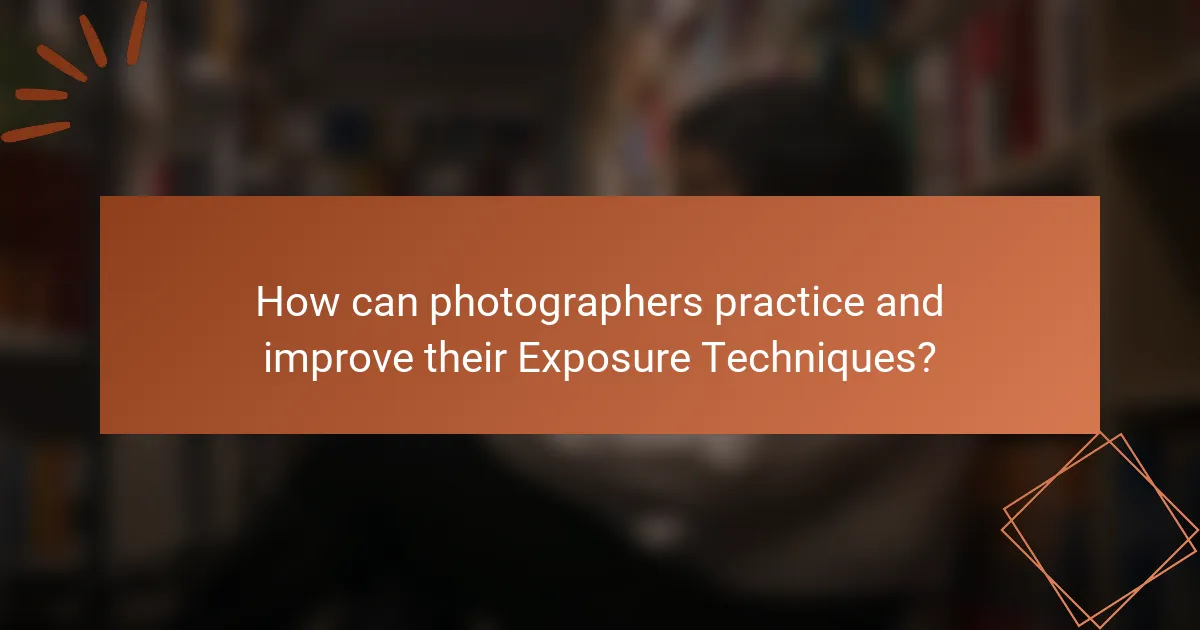
How can photographers practice and improve their Exposure Techniques?
Photographers can practice and improve their exposure techniques by experimenting with different settings on their cameras. They should familiarize themselves with the exposure triangle, which includes aperture, shutter speed, and ISO. Adjusting these settings can significantly affect the exposure of an image. Photographers can also practice using manual mode to gain better control over their settings.
Taking photos in various lighting conditions helps in understanding how light impacts exposure. Additionally, photographers should review their images and analyze the exposure to learn from mistakes. Using tools like exposure meters can provide guidance on achieving the correct exposure. Participating in workshops or online courses focused on exposure techniques can also enhance their skills. Regular practice and seeking feedback from peers can further aid in improvement.
What are some practical exercises for mastering exposure?
Practical exercises for mastering exposure include shooting in manual mode, using a light meter, and practicing bracketing. Shooting in manual mode helps photographers understand the relationship between aperture, shutter speed, and ISO. This direct control allows for experimentation with different settings. Using a light meter provides accurate readings of light in various conditions. This technique helps in making informed exposure decisions. Practicing bracketing involves taking multiple shots at different exposures. This method allows photographers to compare results and learn from their choices. Additionally, photographing in various lighting situations enhances adaptability. Each exercise reinforces understanding and application of exposure principles.
How can shooting in manual mode enhance understanding of exposure?
Shooting in manual mode enhances understanding of exposure by allowing photographers to control aperture, shutter speed, and ISO independently. This control helps in comprehending how each element affects the final image. For instance, adjusting the aperture changes depth of field, while varying shutter speed impacts motion blur. ISO adjustments influence the camera’s sensitivity to light. By experimenting with these settings, photographers can observe real-time effects on exposure. This hands-on experience solidifies theoretical knowledge. Studies show that practical engagement leads to better retention of photographic concepts. Thus, manual mode fosters a deeper grasp of exposure dynamics.
What tips can help photographers when adjusting exposure settings in different lighting conditions?
Photographers can effectively adjust exposure settings by considering the lighting conditions. In bright light, use a faster shutter speed to prevent overexposure. In low light, increase the ISO sensitivity to capture more light. Adjust the aperture to control depth of field and light entry. Use a histogram to evaluate exposure levels accurately. Employ exposure compensation to fine-tune brightness in challenging conditions. Utilize metering modes to assess light correctly, such as spot or center-weighted metering. These methods enhance image quality across various lighting scenarios.
What common challenges do photographers face with exposure?
Photographers often face challenges with exposure due to varying light conditions. Inconsistent lighting can lead to overexposed or underexposed images. Additionally, understanding the exposure triangle—aperture, shutter speed, and ISO—can be complex. Misjudging these settings affects image quality. Furthermore, dynamic scenes, such as fast-moving subjects, complicate exposure adjustments. Metering modes can also confuse photographers, leading to incorrect exposure readings. Finally, post-processing can alter perceived exposure, creating additional challenges. These factors collectively impact a photographer’s ability to achieve the desired exposure in their work.
How can photographers troubleshoot exposure issues in their work?
Photographers can troubleshoot exposure issues by adjusting their camera settings. They should check the ISO, aperture, and shutter speed. Increasing ISO can help in low-light conditions. Decreasing the aperture (higher f-stop number) reduces light intake. Slowing down the shutter speed allows more light to hit the sensor.
Using the histogram feature on the camera helps identify exposure problems. A histogram that is skewed to the left indicates underexposure. A histogram skewed to the right suggests overexposure.
Photographers can also use exposure compensation to adjust brightness. This allows for fine-tuning without changing the primary settings. Taking test shots and reviewing them is essential. This practice helps in making real-time adjustments.
What resources are available for photographers to learn more about exposure techniques?
Photographers can learn about exposure techniques through various resources. Online courses are available on platforms like Udemy and Coursera. These courses cover fundamental and advanced exposure concepts. Books such as “Understanding Exposure” by Bryan Peterson provide in-depth knowledge. Additionally, photography blogs and websites like Fstoppers and PetaPixel offer articles and tutorials. YouTube channels dedicated to photography also provide visual demonstrations of exposure techniques. Workshops and local photography clubs often host sessions focused on practical exposure training. Lastly, forums like Reddit’s r/photography allow for community discussions and tips on exposure.
What are the best practices for achieving optimal exposure in photography?
Achieving optimal exposure in photography involves balancing aperture, shutter speed, and ISO settings. A wider aperture allows more light in, which is beneficial in low-light conditions. A faster shutter speed freezes motion but lets in less light, suitable for bright environments. Adjusting the ISO increases sensitivity to light; higher ISO can introduce noise. Using a light meter helps gauge exposure accurately. Additionally, employing the histogram tool on cameras ensures a balanced exposure across highlights and shadows. Properly exposing images enhances detail and color accuracy, resulting in better overall photographs.
Understanding exposure techniques is crucial for photographers as it involves controlling the amount of light reaching the camera sensor through aperture, shutter speed, and ISO settings. This article outlines how these exposure components impact image quality, including brightness, contrast, and detail, and explains the interplay of these elements using the exposure triangle. It also addresses common mistakes photographers make, practical exercises for mastering exposure, and resources available for further learning. By mastering these techniques, photographers can achieve optimal exposure and enhance their skills in various lighting conditions.
